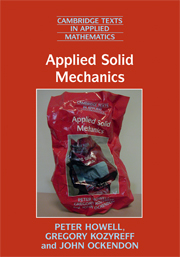Book contents
Fracture and contact
Published online by Cambridge University Press: 02 February 2010
Summary
Introduction
Fracture describes the behaviour of thin cracks, like the one illustrated in Figure 7.1, in an otherwise elastic material. The crack itself is a thin void, whose faces are usually assumed to be stress-free. When a solid containing a crack is stressed, we will find that the stress is localised near the crack tip, becoming singular if the tip is sharp. We will see that the strength of the singularity can be characterised by a stress intensity factor, which depends on the size of the crack and on the applied stress. This factor determines the likelihood that a crack will grow and, therefore, that the solid will fail.
On the other hand, contact refers to the class of problems in which two elastic solid bodies are brought into contact with each other, as illustrated in Figure 7.2. When the material properties are the same in the two bodies, the geometrical configuration near the edge of the contact region is apparently similar to that of fracture, with voids now outside the contact set, that is, the set of points at which the two solids are in contact. The mathematical setup of such problems does therefore have some similarity with fracture, but, in the steady state, there is one crucial difference. Whereas much of the study of fracture concerns cracks of prescribed length, in contact problems the contact set itself is often unknown in advance. They are thus known as free boundary problems, that is problems whose geometry must be determined along with the solution.
- Type
- Chapter
- Information
- Applied Solid Mechanics , pp. 287 - 327Publisher: Cambridge University PressPrint publication year: 2008

